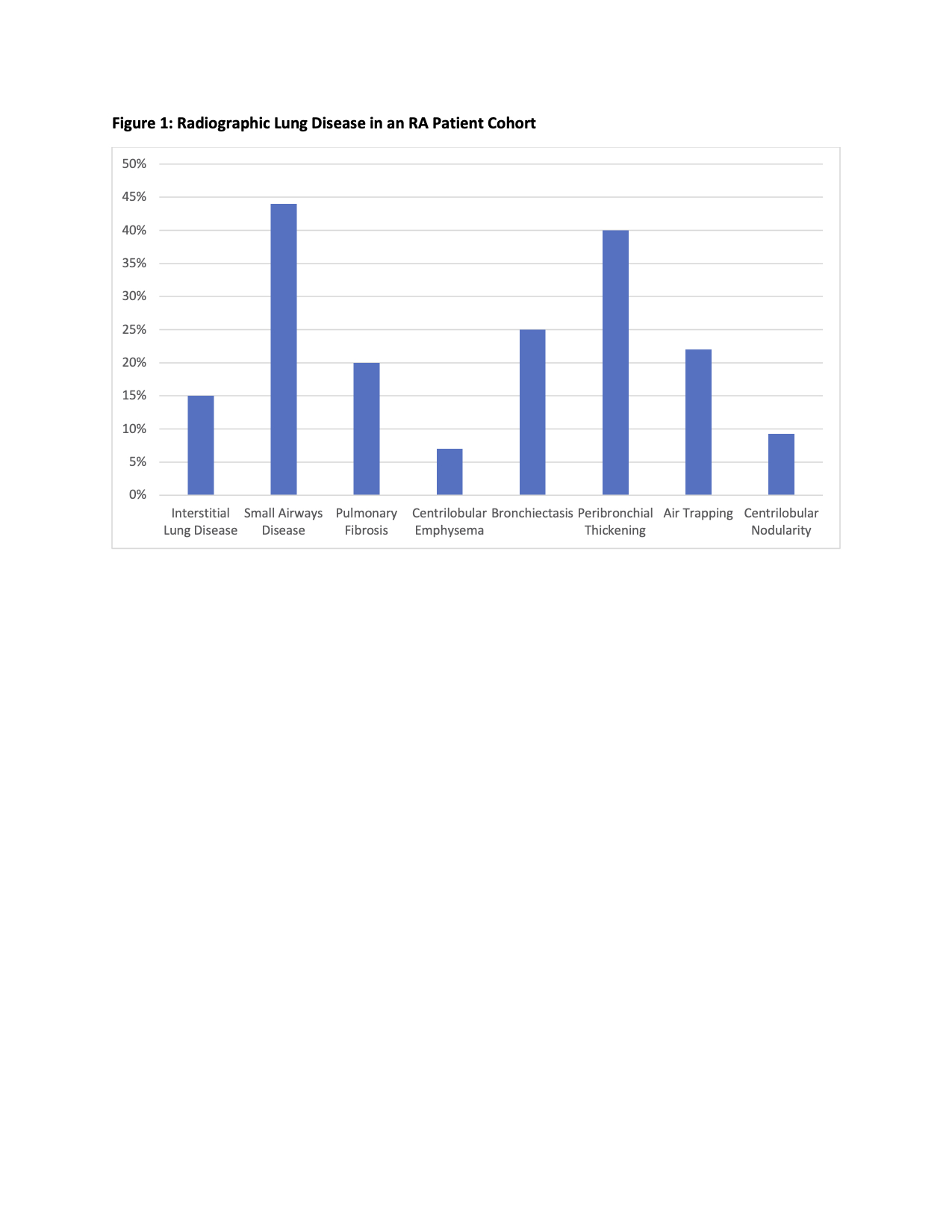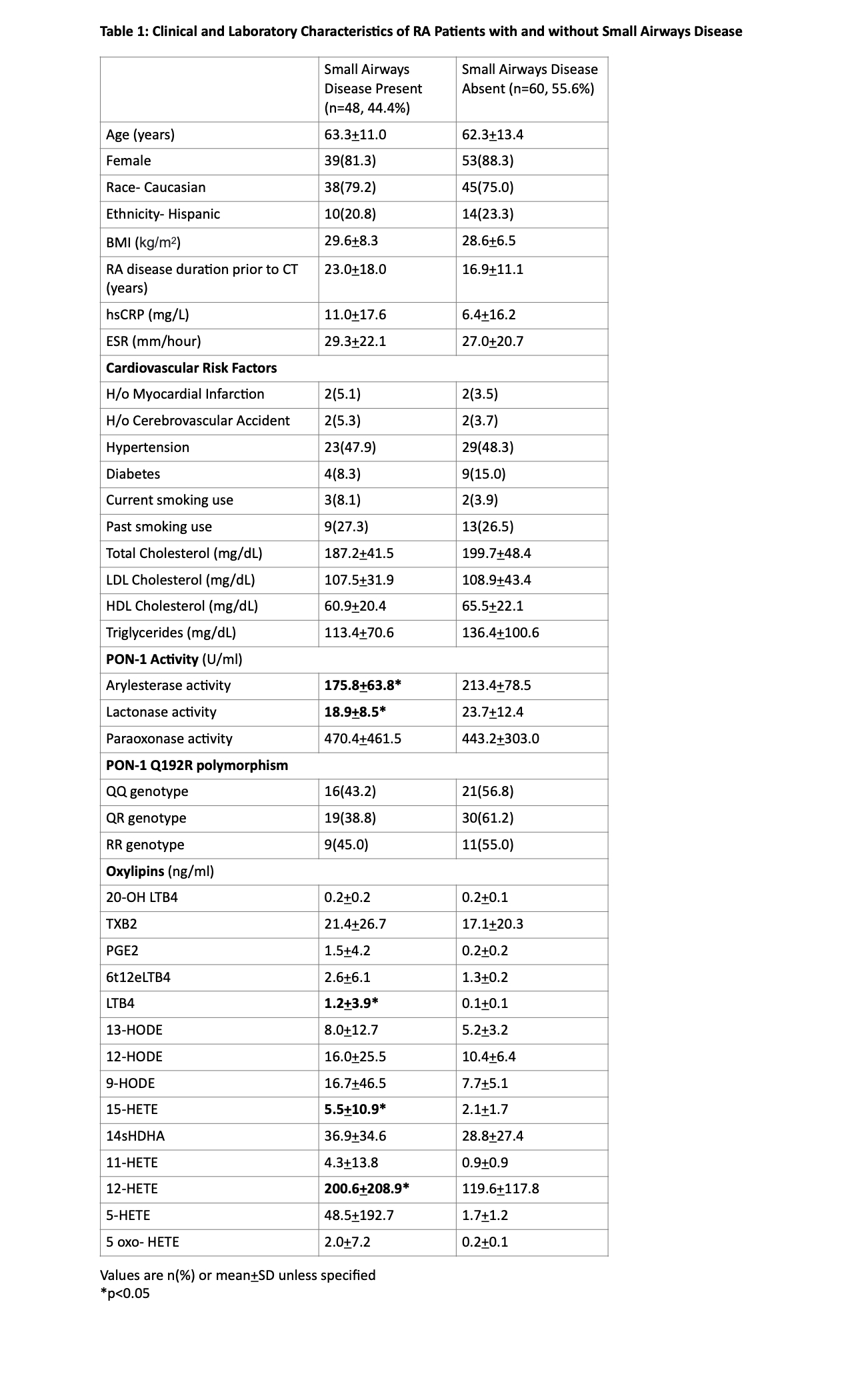Session Information
Date: Saturday, November 6, 2021
Title: RA – Diagnosis, Manifestations, & Outcomes Poster I: Cardiovascular Pulmonary Disease (0268–0295)
Session Type: Poster Session A
Session Time: 8:30AM-10:30AM
Background/Purpose: Lung disease in patients with rheumatoid arthritis (RA) is common and associates with significantly increased morbidity and mortality. Oxidative stress plays an important role in the inflammatory responses in airway diseases such as asthma and COPD, but has not been fully investigated in RA-associated lung disease (RA-LD). In the current work, we evaluated associations of the biochemical and genetic determinants of the anti-oxidant HDL-associated protein, paraoxonase 1 (PON-1), and measures of systemic oxidative stress with the presence of RA-LD in a longitudinal RA cohort.
Methods: This study was conducted as a retrospective chart review of a longitudinal single-center cohort of 250 RA patients. All RA patients with an available computed tomographic (CT) scan of the chest were included in the analysis. Scans were reviewed by the interpreting radiologist for the presence of interstitial lung disease (ILD), bronchiectasis, pulmonary fibrosis, centrilobular emphysema, and small airways disease (SAD). SAD was defined by the presence of peribronchial thickening, air trapping, or centrilobular nodularity. PON-1 activity was measured by its lactonase, arylesterase, and paraoxonase activities, the PON-1 Q192R polymorphism, and total plasma oxylipins were measured as described previously (Sci Rep2020 Oct 8;10(1):16848, A&R 2013Nov:65(11):2765-72).
Results: Out of 250 RA patients, 108 (43.2%) had CT scans of the chest available for review. The distribution of lung disease involvement in the cohort (figure 1) included 48 patients (44.4%) with SAD and demonstrated peribronchial thickening in 43 (39.8%), air trapping in 24 (22.2%), and centrilobular nodules in 10 (9.3%). Patients with SAD demonstrated significantly lower PON-1 activity as measured by both arylesterase and lactonase activities and higher levels of several oxylipins compared to patients without SAD (Table 2). Lower PON-1 activities correlated with higher levels of 12-HETE, 15-HETE, and 20-OH LTB4 (r = -0.2- -0.3, p < 0.05). In multivariate logistic regression analyses controlling for known SAD risk factors (RA disease duration, age, sex, smoking, and obesity), lower lactonase and arylesterase activities of PON-1, and higher levels of 12-HETE and 15-HETE remained independently associated with the presence of SAD in RA patients. Such associations were not noted with other types of RA-LD (data not shown).
Conclusion: RA patients with radiographic evidence of SAD demonstrate significantly lower arylesterase and lactonase activities of PON-1 and higher levels of systemic oxidative stress measured by circulating oxylipins, including higher 12-HETE and 15-HETE, which correlated with reduced PON-1 activity. Future studies are warranted to evaluate the relationship of PON-1 and pro-inflammatory oxylipins to the pathogenesis of RA lung disease.
To cite this abstract in AMA style:
Razmjou A, Wang J, Shahbazian A, Reddy S, Charles-Schoeman C. Suppressed Paraoxonase-1 Activity and Elevated Oxylipins Associate with the Presence of Small Airways Disease in Patients with Rheumatoid Arthritis [abstract]. Arthritis Rheumatol. 2021; 73 (suppl 9). https://acrabstracts.org/abstract/suppressed-paraoxonase-1-activity-and-elevated-oxylipins-associate-with-the-presence-of-small-airways-disease-in-patients-with-rheumatoid-arthritis/. Accessed .« Back to ACR Convergence 2021
ACR Meeting Abstracts - https://acrabstracts.org/abstract/suppressed-paraoxonase-1-activity-and-elevated-oxylipins-associate-with-the-presence-of-small-airways-disease-in-patients-with-rheumatoid-arthritis/



